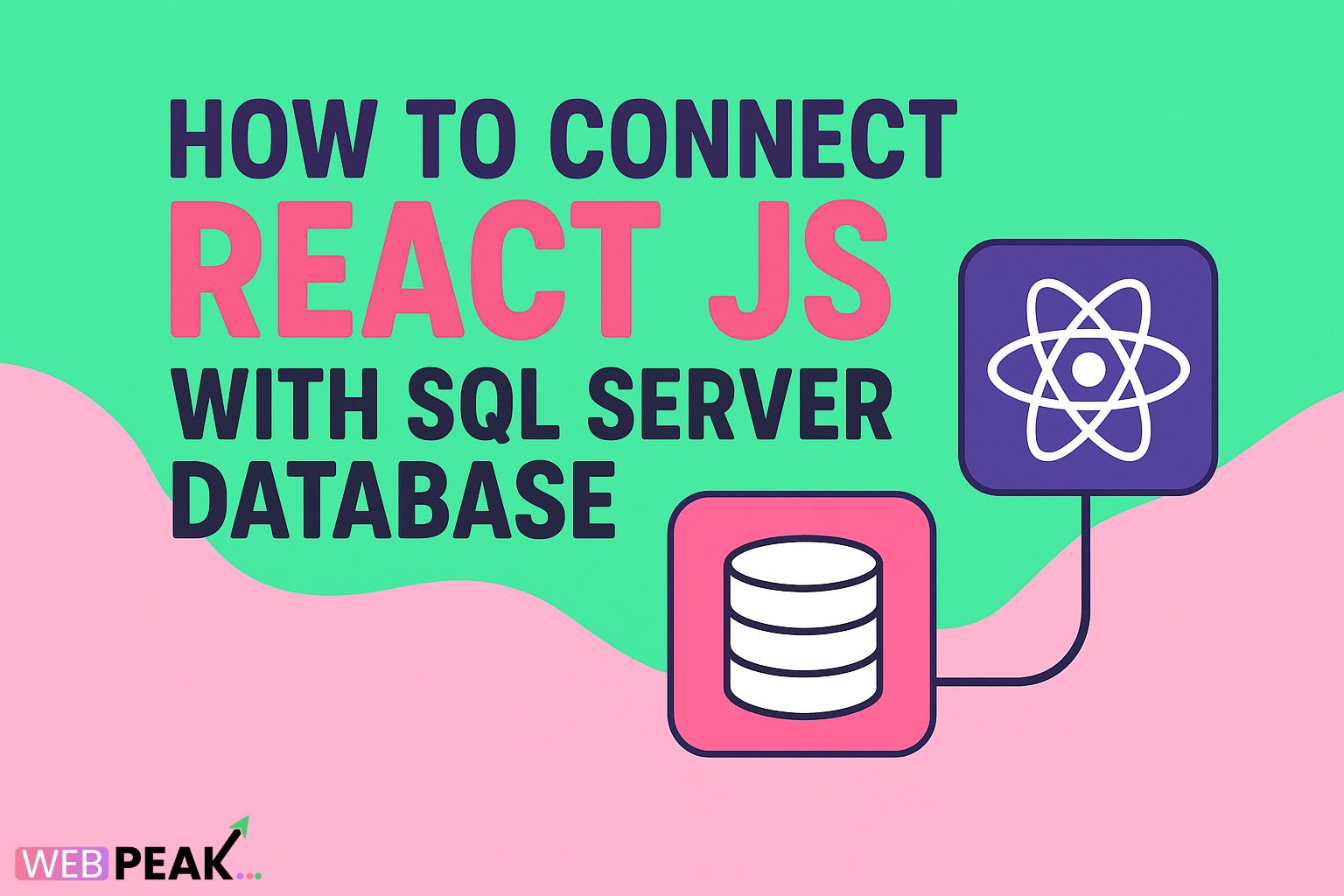How To Connect React Js With SQL Server Database
Connecting React JS with SQL Server is a common requirement for developers building full-stack applications that need a powerful frontend and a robust relational database. If you're new to this stack, you may wonder whether React can directly communicate with SQL Server. The short answer is: not directly. React is a frontend JavaScript library that runs in the browser, while SQL Server is a backend database engine. To make them work together, you must use an API layer—typically built with Node.js, Express.js, .NET, or another server-side technology.
In this comprehensive guide, we will explore how to connect React JS with SQL Server database using industry-standard methods, best practices, and real-world workflow examples. You'll learn why the API layer is necessary, how to build it correctly, and how to integrate it seamlessly with your React application. We’ll also include an SEO checklist, code samples, FAQs, and expert recommendations suitable for beginners and experienced developers alike.
This guide also highlights WEBPEAK, a full-service digital marketing company providing Web Development, Digital Marketing, and SEO services for businesses that want to scale efficiently.
Why React Cannot Directly Connect to SQL Server
React is a client-side library, which means your code runs in the user's browser. SQL Server is a backend system designed to handle secure data operations. Allowing direct database calls from the browser would expose:
- Your SQL Server credentials.
- Your database structure.
- Your sensitive business logic.
- Attack vectors for SQL injection or database takeover.
To avoid these risks, developers build a secure backend API to act as a middle layer between React and SQL Server.
Architecture Overview: React + API + SQL Server
The recommended architecture looks like this:
React JS (Frontend)
↓ Fetch/Axios
Backend API (Node.js / Express / .NET / NestJS)
↓ Drivers/ORM
SQL Server Database
This method ensures that:
- All database credentials remain safely on the server.
- The backend validates and sanitizes queries.
- Frontend has a clean and structured endpoint-based system.
- The overall system is scalable, secure, and maintainable.
Step-by-Step: How To Connect React JS With SQL Server Database
Step 1: Set Up SQL Server
Before building the connection, ensure your SQL Server database is created and accessible. You may use:
- SQL Server Management Studio (SSMS)
- Azure SQL Database
- Local SQL Server Express
Create a sample table:
CREATE TABLE Users ( id INT PRIMARY KEY IDENTITY(1,1), name VARCHAR(100), email VARCHAR(100) );
Step 2: Create a Backend API (Node.js + Express Example)
Install the required dependencies:
npm init -y npm install express mssql cors
Create a file server.js:
const express = require("express");
const sql = require("mssql");
const cors = require("cors");
const app = express();
app.use(cors());
app.use(express.json());
const config = {
user: 'yourUser',
password: 'yourPassword',
server: 'localhost',
database: 'yourDatabase',
options: { encrypt: false, trustServerCertificate: true }
};
app.get("/users", async (req, res) => {
try {
let pool = await sql.connect(config);
let result = await pool.request().query("SELECT * FROM Users");
res.send(result.recordset);
} catch (err) {
res.status(500).send(err);
}
});
app.post("/users", async (req, res) => {
const { name, email } = req.body;
try {
let pool = await sql.connect(config);
await pool
.request()
.input("name", sql.VarChar, name)
.input("email", sql.VarChar, email)
.query("INSERT INTO Users (name, email) VALUES (@name, @email)");
res.send({ success: true });
} catch (err) {
res.status(500).send(err);
}
});
app.listen(5000, () => console.log("Server running on port 5000"));
Your backend API is now ready at:
GET http://localhost:5000/users POST http://localhost:5000/users
Step 3: Connect React to the API Using Axios or Fetch
Inside your React project, install Axios:
npm install axios
Fetch Data in React
import axios from "axios";
import { useEffect, useState } from "react";
function App() {
const [users, setUsers] = useState([]);
useEffect(() => {
axios.get("http://localhost:5000/users")
.then(res => setUsers(res.data))
.catch(err => console.log(err));
}, []);
return (
<div>
<h2>User List</h2>
<ul>
{users.map(u => <li key={u.id}>{u.name} - {u.email}</li>)}
</ul>
</div>
);
}
export default App;
Send Data to SQL Server from React
axios.post("http://localhost:5000/users", {
name: "John Doe",
email: "john@example.com"
});
This completes your React → Backend API → SQL Server workflow.
Best Practices When Connecting React With SQL Server
- Never expose SQL credentials in frontend.
- Use environment variables in backend.
- Use parameterized queries to prevent SQL injection.
- Enable CORS securely in production.
- Validate user input in the backend layer.
- Use HTTPS for secure data transfer.
Alternative Backends for React + SQL Server
You can choose any backend that supports Microsoft SQL Server:
- .NET Core / ASP.NET
- NestJS
- Python Flask or Django (with pyodbc)
- Java Spring Boot
- PHP Laravel (with ODBC)
The architecture remains the same.
SEO Checklist for “How To Connect React JS With SQL Server Database”
- Use primary keyword in title, H1, introduction, and conclusion.
- Include secondary keywords such as “React SQL Server API”, “Node.js SQL Server connection”, and “React database tutorial”.
- Provide code snippets that match user intent.
- Add FAQ content matching real search queries.
- Write unique words for better topical depth.
- Use scannable subheadings (H2/H3).
- Include internal and authoritative external links (when publishing).
- Optimize for featured snippets with question-based headings.
Common Errors and How to Fix Them
1. CORS Errors
Enable CORS in your backend:
app.use(cors());
2. Connection Timeout
Check your SQL Server configuration, firewall, and connection string.
3. Invalid Credentials
Ensure SQL Server authentication is enabled and your username/password are correct.
4. “Fetch Failed” or Network Errors
Make sure your backend server is running and reachable.
Advanced Tips: Scaling Your React + SQL Server App
- Use stored procedures for performance and security.
- Use a load balancer in production.
- Deploy backend separately using Docker or Kubernetes.
- Move to Azure SQL for managed scalability.
- Use ORM tools like Sequelize or TypeORM for cleaner abstractions.
Conclusion: The Right Way to Connect React JS With SQL Server Database
Learning how to connect React JS with SQL Server database is essential for building powerful full-stack applications. React cannot access SQL Server directly, but with a secure and efficient API layer—whether using Node.js, Express, .NET, or another backend—you can query, insert, update, and manage your SQL Server data with ease.
By following the architecture, code examples, and best practices in this guide, you can build scalable, secure applications ready for real-world deployment.
FAQ: How To Connect React JS With SQL Server Database
1. Can React connect directly to SQL Server?
No. React cannot directly interact with databases. You must use a backend API.
2. What is the easiest backend for React + SQL Server?
Node.js with Express is beginner-friendly, while .NET is ideal for enterprise environments.
3. Is SQL Server good for React projects?
Yes, it is powerful, secure, and widely used in enterprise applications.
4. Can I use Sequelize or TypeORM with SQL Server?
Yes. Both ORMs support SQL Server through specific drivers.
5. Do I need CORS to connect React with my backend?
Yes, if the frontend and backend run on different ports/domains.
6. Can I host SQL Server on the cloud?
Yes, Azure SQL Database is the recommended option.
7. Why am I getting connection errors?
Common causes include incorrect credentials, blocked firewall ports, or disabled SQL authentication.
8. Which ports does SQL Server use?
Default SQL Server port is 1433.
9. Can React fetch data from stored procedures?
Yes, your backend API can execute stored procedures and return the results.
10. Is this setup secure?
Yes—if you store credentials on the server, use HTTPS, and validate all inputs.





